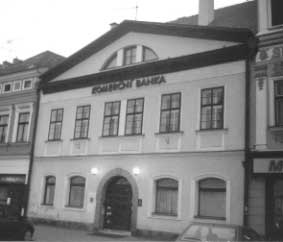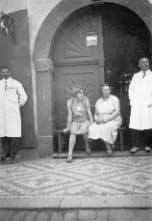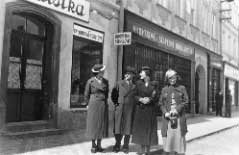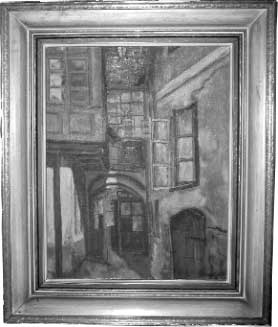The Story of a Home Owner
Mrs. Ema Bondy's maiden name was Rosenbaum and she was born on 27th November, 1876. She lived in her own house at what is now 31, Smetana Square. Eyewitnesses remember her mainly from the time when she was left living alone in Litomyšl in the 1930s. Her son lived with his wife in Vienna at that time but he used to visit his mum. Ema spoke German to him and his wife, but Czech to the people in the house. They called her Bondová.
"The people from the house" were Mr. Hochman and his wife and daughter, a widow; Mrs. Šmejcová and her two children, Olga and Milan and Mr. Chládek and his wife and daughter, Dagmar. Olga, whose married name is Rejmanová, remembers that Mrs. Bondy wanted the children to greet her using Guten Tag. She gave the children the pet names of Oluška and Milánek. She used to say, "Milánek (Oluška), come here, would you like a bit of sugar?" And she would give them a sugar cube and some water to wash it down.
As far as Ema´s father, Mr. Rosenbaum, is concerned, we know that he was a worrier. He would go to the railway station one hour before his train was due to leave so he wouldn't miss it. Mrs. Rejmanová remembers her mum, Mrs. Šmejcová, saying, "Well, here I go - behaving like old Rosenbaum."
Mrs. Bondy was friends mainly with Mrs. Hochmanová. In the evenings, she used to sit with her on a bench in the square, facing the wooden gate leading to the house. Both women spoke to each other in the third person (an old-fashioned formal way of addressing people). Mrs. Hochman usually asked, "What is Mrs. Bondová going to cook?". Normally, the answer was, "Well, she has some steak."
Mrs. Bondy spent most of the day in the kitchen. She would put on a short cloth 'home' jacket and balance her spectacles on her nose and read. When the weather was nice, she would sit in the courtyard, on a bench on the lawn under an old greengage tree and do her handiwork.
Mrs. Bondy helped Mrs. Libochowitz, the wife of the priest from the synagogue, to wash and dress the dead. She used to say that she was not very good at it but ´I can always manage to put the stockings on them'.
When the Germans turned the grammar school into a hospital for their army, Mrs. Bondy had to move from her flat on the first floor, and Mr. Nohava, a caretaker at the grammar school, moved there instead. Mr. Hochman let her live in a room behind his barbershop, where she stayed until she was sent to the ghetto. When she was leaving on 2nd December, 1942, she said goodbye to Mrs. Hochman in the kitchen. She was said to have had a big package lying at her feet and was wearing a fur coat. Mrs. Olga Rejmanová remembers that, even though she was a little girl at the time, she said to herself that she would probably never see her again. Ema Bondy was kept at Terezín until 15th December, 1943, when she left on Dr transport as number 200 for Auschwitz never to return.
Thanks to the memories of Mrs. Rejmanová and Mrs. Šplíchalová, née Chládková, we can imagine what Mrs. Bondy´s house looked like and what happened to it.
Before the war, Mr. Hochman´s barbershop was on the left-hand side of the ground floor. The shop led to the square and was separated by a glass door from another, very dark room without windows. This room led to a larder. To the right of the entrance to the house, was Mrs. Chládková's hat shop, also with a dark room behind it. It was used as a kitchen and was connected to a larder with windows. Another room without windows led to the courtyard. Because it was not possible to air the room, it was always damp.
A narrow, winding staircase was used to get to the first floor. The entrance to the flat of the owner, Mrs. Bondy, was in a little space on the left, above the staircase. The first room behind the front door was a kitchen with a skylight and the two connected rooms had windows with a view of the square. To the right of the staircase was the flat belonging to Mr. Hochman´s family. It was made up of a dark kitchen, two rooms with windows leading to the square, and a back room, looking out on the courtyard, with windows and which lead to a wooden back porch. Mr. Hochman´s family lived there. Neither flats had bathrooms. A pipe in the corridor above the staircase led to a shared, tap-fitted washbasin. A shared toilet without a water supply was at the back porch.
At the back of the house, there was quite a large courtyard with a small lawn and a tree. It was surrounded by walls on all sides.
When Mrs. Bondy did not return after the war and no relative claimed the property, it was given to the National Property Fund. Mr. Nohava went back to his flat in the grammar school. The family of Chládková, the dressmaker, moved from the ground floor to the first floor flat, which the caretaker had left. The rooms behind the hat shop were never used again for living, only as storerooms.
When Mr. Hochman´s barbershop and Mrs. Chládková´s hat shop were put under state ownership, the barbers continued working in the barbershop, but the hat shop was replaced by a hairdresser's.
In 1975, the building was changed into a Service Centre with a barbershop, a hairdresser's, and a beauty salon.
After 1989, the house was renovated. Ist owner
Dagmar Burdová and Karolína Osecká




